Thursday, November 16, 2006
Trenton Duckett new eyewitnesses
Monday, October 30, 2006
Some new updates
Deleting Online Predators Act of 2006
Touched her heart or hit a nerve
Automatic Amber Alerts?
Cajun, cameras, consent
School Dazed
Getting there is half the fun
MySpace … MySolutions?
Famous or infamous?
Bus…ted in Brownsville
Injury by omission
Monday, September 11, 2006
Melinda Duckett
Monday, August 21, 2006
Recent posts of interest
Recent Posts:
Goose and the Gander
How Dangerous Is Childhood?
How Dangerous Is Childhood (con’t)
How Dangerous Is Childhood (con’t)
How Dangerous Is Childhood? (final)
Match game
Let your fingers do the walking
Horse of a different color?
Lost and Found
It is better to give than to receive
Wednesday, August 16, 2006
Innocence lost
Childhood - and parenthood - would never be the same.
On Aug. 10, 1981, the severed head of the South Florida boy was found in a canal in Vero Beach.
If a 6-year-old could be taken from a mall after being out of his mother’s sight for just minutes; if he could be murdered and decapitated; if his killer could elude authorities, then our world must be a truly dangerous place for children.
It’s an understandable response to what was surely one of the most horrific crimes of the 20th century.
But the fallout - a culture of parental paranoia that has become the norm today - may be just as tragic.
The casualties, beyond the death of one innocent little boy, are many:
The death of simple childhood pleasures.
The death of peace of mind.
The death of common sense.
The death of self-sufficiency.
Read more When a child goes missing
Sunday, August 13, 2006
Horse of a different color
John Larson started his article with a couple of observations.
For generations parents have warned their children about “the stranger”: Don’t take candy, accept a ride, or even talk to somebody you don’t know.
But what if that somebody is a family friend? Somebody parents know and trust?
The two people who came to mind were Peter Whitmore and Mary Kay Latourneau.
Wednesday, August 09, 2006
Deion Santistevan
It doesn’t mention if they were located as a result of the Amber Alert.
Monday, August 07, 2006
Colorado Amber Alert
Is an Amber Alert still effective if it is issued over nine hours after an abduction?
According to the Colorado Bureau of Investigation one of the purposes for issuing an Amber Alert is to rapidly disseminate information.
Is it effective if it is activated and de-activated during the search efforts?
Multiple Amber Alerts have been issued recently in the efforts to recover Daniel Jimenez, and Elian Majano both still missing. They were also issued multiple times in the abduction of Destiny Norton.
Amber Alert Process
Once law enforcement has been notified about an abducted child, they must first determine if the case meets the AMBER Plan criteria:
The child must be 17 years of age or younger
The child must be in immediate danger of serious bodily harm or death
There must be enough descriptive information to believe a broadcast will assist or aid in the recovery
The activation must be requested by a local local law enforcement agency or AMBER Designee from another state.
To rapidly disseminate information about a suspect and child to law enforcement agencies and the public when a child has been abducted
To gain the assistance of thousands of television viewers and radio listeners throughout the coverage area
To coerce the kidnapper to release the child for fear of arrest
To deter persons from commiting the crime
Thursday, August 03, 2006
Out of sight out of mind?

The media is filled with sensational stories concerning abducted children. Stories of runaways rarely are published or in some cases even addressed by law enforcement. However, the number of runaways far exceeds the number of abducted children.
Many also become victims but, the main difference is the runaway’s fate may never be included in missing child statistics. You can argue they place themselves in danger by running away but you can argue, in some recent child abductions, they too were placed in danger by their actions.
The California Department of Justice reported 112,015 missing children (runaways) in 2005 and 524,262 in the period of 2001-2005.
Read more
Tuesday, August 01, 2006
Hold the bacon

Six degrees of separation is the theory that anyone on earth can be connected to any other person on the planet through a chain of acquaintances with no more than five intermediaries.
Let’s put this theory to the test by examining HR 5319 which is a bill introduced to amend the Communications Act of 1934 to require recipients of universal service support for schools and libraries to protect minors from commercial social networking websites and chat rooms.
This immediately brings to mind MySpace which some consider the premier lifestyle portal for connecting with friends and discovering popular culture. MySpace, a $580 million acquisition, is a unit of Fox Interactive Media Inc. Fox is part of “The News Corporation”.
Rupert Murdoch has grown “The News Corporation” into one of the largest and most influential media groups in the world. The company owns some of the largest and most popular brands in many areas of the media industry including: 20th Century Fox, Fox Television Studios, DIRECTV, Harper Collins Publishers, Festival Records and the New York Post.
“I’m a catalyst for change … You can’t be an outsider and be successful over 30 years without leaving a certain amount of scar tissue around the place.” Rupert Murdoch
One of Fox’s television programs is America’s Most Wanted, AMW, which is hosted by John Walsh. His hard work and determination helped to pass the Missing Children’s Assistance Act of 1984 which created National Center for Missing and Exploited Children NCMEC which now serves as the national clearinghouse for information on missing children and the prevention of child victimization.
On June 21, 2006, the NCMEC praised MySpace’s for its new enhanced safety features.
“We know that children can benefit greatly from being online,” said Ernie Allen, President and CEO of the National Center for Missing & Exploited Children (NCMEC). “We commend MySpace for adding new safety and security features that will help provide protection to their youngest members, so they can have a safer online experience.”
By a vote of 410 to 15, the US House of Representatives passed yesterday H.R. 5319 “Deleting Online Predators Act” (DOPA), which amends the Communications Act of 1934 to require schools and libraries receiving federal money to protect minors from commercial social networking websites. Social networking sites such as MySpace.com may soon be inaccessible to minors from libraries and schools receiving federal funding.
The NCMEC receive approximately $35 million annually in federal funding, in part to protect children from being exploited.
Friday, July 28, 2006
President Bush signs HR 4472
The legislation, called the Adam Walsh Child Protection and Safety Act of 2006, is named for Adam Walsh, a 6-year-old boy who was abducted 25 years ago on July 27, 1981, and eventually killed.
Read more
Thursday, July 27, 2006
Bill expected to be signed today
"...The bill still needs to have funding passed separately, Walsh says. "Legislation without oversight and without money is just a photo-op."
Projected cost $1.2 billion for the first couple years. The bill calls for:
• 500 new U.S. marshals. "They will only look for rapists and sexual predators of children," Walsh says.
• 35 new FBI agents, "dealing with only with cyber crimes over the Internet."
• Expanded efforts to catch pedophiles who use the Internet. Walsh credited NBC's "Dateline" and Oprah Winfrey for demonstrating the size of the problem.
• A standardized sex offender registry in each state.
• The collection of DNA from all convicted sex offenders.
• A requirement that convicted pedophiles submit a new photo to authorities every three months..."
Read the entire article
Wednesday, July 26, 2006
When a child goes missing
Why are the major news outlets covering Destiny Norton's death but had little interest in her disappearance or search?
How many reported missing children cases have actually been resolved by the National Center for Missing and Exploited Children ® (NCMEC) since 1984?
What are the resolutions of those cases? Recovered unharmed/harmed? Not recovered? Murdered?
How do they compare statistically with all missing children reported during the same timeframe but not reported to NCMEC?
Why does the NCMEC refer to statistics, concerning murdered children, from the Office of the Attorney General of Washington State which was a study conducted in 1997? Are these statistics still relevant today?
View their site and are they basing their conclusions on studies that are four years old?
“…How many missing children are there?
Answer: The problem of missing children is complex and multifaceted. There are different types of missing children including family abductions; endangered runaways; nonfamily abductions; and lost, injured, or otherwise missing children. The best national estimates for the number of missing children are from incidence studies conducted by the U.S. Department of Justice's Office of Juvenile Justice and Delinquency Prevention.
To date two such studies have been completed. The first National Incidence Studies of Missing, Abducted, Runaway, and Thrownaway Children (NISMART-1) was released in 1990, and the second, known as NISMART-2, was released in October 2002. …”
In the year 2006, with all the technology available and all their technology partners, shouldn’t they have more current information? They receive approximately $40 million annually to fulfill their National Mandate and Mission. They tout the number of tips, calls etc and their 94% recovery rate so they must have some basis for the numbers.
“…The National Center for Missing & Exploited Children’s® (NCMEC) mission is to help prevent child abduction and sexual exploitation; help find missing children; and assist victims of child abduction and sexual exploitation, their families, and the professionals who serve them.
NCMEC was established in 1984 as a private, nonprofit 501(c)(3) organization to provide services nationwide for families and professionals in the prevention of abducted, endangered, and sexually exploited children. Pursuant to its mission and its congressional mandates (see 42 U.S.C. §§ 5771 et seq.; 42 U.S.C. § 11606; 22 C.F.R. § 94.6), NCMEC ..”
The National Child Search Assistance Act of 1990 requires each federal, state, and local law-enforcement agency to enter information about missing children younger than the age of 18 into the Federal Bureau of Investigation's (FBI) National Crime Information Center (NCIC) database. The Act also establishes state reporting requirements.
Can statistics not be extracted from the NCIC database?
Tuesday, July 25, 2006
Destiny Norton
Destiny found dead
Police arrest a man living next door
By Nate Carlisle The Salt Lake Tribune
The Salt Lake Tribune reported the body of Destinty Norton had been found in the basement of her next door neighbor, Craig Roger Gregerson, 20.
Monday, July 24, 2006
America's Most Wanted coverage
By all accounts, her story has been mostly a regional story with little, if any, national coverage. Since her pictures and story have been on the internet for over a week, will a short blurb on AMW help that much?
It is somewhat ironic with the vote on H.R. 4472, the ‘‘Adam Walsh Child Protection and Safety Act of 2006’’ and the upcoming 25th anniversary of his death, you might have thought there would have been more coverage of her disappearance.
Saturday, July 22, 2006
‘‘Adam Walsh Child Protection and Safety Act of 2006’’.

H.R. 4472 ‘‘Adam Walsh Child Protection and Safety Act of 2006’’.
You know the old saying, “…To many Chef’s can spoil the broth…”? Read through this 164 page PDF, and perhaps it will help explain why it took so long to pass and could take three years to implement.
However this is one broth that in the end we trust will turn out well for the victims of these crimes.
Was the voice vote unanimous and the reason no representatives position was kept?
Votes on Passage
Mar 8, 2006: This bill passed in the House of Representatives by voice vote. A record of each representative's position was not kept.
Jul 20, 2006: This bill passed in the Senate by Voice Vote. A record of each representative's position was not kept.
A picture's worth a thousand words
 A month ago there was discussion over whether the Irving, Texas police department followed proper procedure for issuing an Amber Alert for two year old Elian Majano. One month later, the child is still missing and the alert is still in effect.
A month ago there was discussion over whether the Irving, Texas police department followed proper procedure for issuing an Amber Alert for two year old Elian Majano. One month later, the child is still missing and the alert is still in effect.Read more
Friday, July 21, 2006
Hurry up and wait.
Why will it be required to be up and running within three years. Wonder what the statistics published concerning offenses committed during this time frame will be?
If each state maintains these records on-line now, why will it take three years to ensure implementation? Is it possible each state doesn't keep accurate records now and needs three years to "find" sex offenders?
What are the penalties to each state if they don't comply? We know what it can be for society.
Thursday, July 20, 2006
Book of lists

If you believe the wheels of justice turn slowly, you might want to read about the National Sex Offender Registry bills introduced over a year ago. Expected to be voted on today, it could be signed into law July 27th.
Library of Congress
S.1086 Title: A bill to improve the national program to register and monitor individuals who commit crimes against children or sex offenses. Sponsor: Sen Hatch, Orrin G. [UT] (introduced 5/19/2005) Cosponsors (42) Related Bills: H.R.2423 Latest Major Action: 5/8/2006 Held at the desk.
H.R.2423 Title: To improve the national program to register and monitor individuals who commit crimes against children or sex offenses. Sponsor: Rep Foley, Mark [FL-16] (introduced 5/18/2005) Cosponsors (86) Related Bills: S.1086 Latest Major Action: 6/9/2005 House committee/subcommittee actions. Status: Subcommittee Hearings Held.
According to Congressman Mark Foley (FL-16), "...there are currently over 500,000 registered sex offenders in the United States – with 24,000 of them living in North Carolina and Virginia alone. Of that, according to the National Center for Missing and Exploited Children, we are missing between 100,000 to 150,000 of these predators.
What may be even more surprising to you is that there is a 200,000 person difference between all of the state registries and the federal National Sex Offender Registry (NSOR).
The House and Senate may vote today on the proposed bill which would make it a crime for sex offenders not to register with their state and would require states to share information when an offender moved to a new state...:
If approved, the new sex offender registry would replace the state-by-state system now in place. Under current law, offenders usually report once a year. Failure to report is a misdemeanor.
Could bill have helped Destiny Norton?
Wednesday, July 19, 2006
Profile of a child killer
The average killer of abducted children is 27 years old
85 percent are unmarried
Half are unemployed
51 percent live either alone or with their parents
61 percent have prior arrests for violent crimes
66 percent have a legitimate reason to be in the area where the abduction takes place
Source: Attorney General of Washington State, U.S. Department of Justice
Read more click here
Tuesday, July 18, 2006
Profile of an abducted and murdered child
76 percent of children killed by their abductor are girls
The average age is between 11 and 12 years old
57 percent are victims of opportunity
14 percent are chosen because of some physical characteristic
Well over half of all child abductions that lead to murder happen within three blocks of the victim's home.
Source: Attorney General of Washington State, U.S. Department of Justice
Read more click here
Monday, July 17, 2006
They care....but not that much
The following is a brief summary of the Act introduced in 2003 as HR 1104 Child Abduction Prevention Act.
“…Child Abduction Prevention Act - Title I: Sanctions and Offenses - (Sec. 101) Amends the Federal criminal code to:
(1) make the authorized term of supervised release after imprisonment any term of years or life, and to require a sentence to include a term of supervised release of at least five years, for kidnaping involving a minor and for other specified felony offenses (aggravated sexual abuse, sexual abuse, abusive sexual contact, sexual exploitation of children, selling or buying of children, certain activities relating to material involving the sexual exploitation of minors and material constituting or containing child pornography, production of sexually explicit depictions of a minor for importation into the United States, transportation for illegal sexual activity, coercion and enticement to engage in criminal sexual activity, transportation of minors with intent to engage in criminal sexual activity or in a sexual act with a juvenile, or use of interstate facilities to transmit information about a minor with intent to solicit any person to engage in criminal sexual activity) (listed offenses);
(2) include aggravated child abuse and child torture murders within the scope of the definition of first degree murder; and
(3) increase penalties for sexual exploitation and other abuse of children, for transportation for illegal sexual activity and related crimes, and for kidnapping children…”
Why would you, if you were a member of Congress, either vote No or Not vote at all?
Democratic
No
John Conyers, Jesse Jackson, Stephanie Jones, Barbara Lee, Jim McDermott, Alan Mollohan, James Oberstar, Martin Sabo, Robert Scott, Pete Stark, Maxine Waters, Melvin Watt
Not voting
Corrine Brown, William Clay, Richard Gephardt, Karen McCarthy, George Miller
Independent
No
Bernard Sanders
Republican
No
Ron Paul
Not Voting
Steve Buyer, Larry Combest, Ernest Fletcher, Henry Hyde, Thad McCotter
Saturday, July 15, 2006
Food for thought
 When designing sales territories, an analogy of approaching the territory like a pie has often been suggested. In other words, do you believe there are only a certain finite number of slices in the pie, so you need to protect your slice (share), or is the pie so large collectively you could never eat the entire pie. The size of the slice doesn’t matter.
When designing sales territories, an analogy of approaching the territory like a pie has often been suggested. In other words, do you believe there are only a certain finite number of slices in the pie, so you need to protect your slice (share), or is the pie so large collectively you could never eat the entire pie. The size of the slice doesn’t matter.I posted this on “When a child goes missing” concerning the number of reported missing children. The NCMEC receives approximately $40,000,000 annually from the Department of Justice and donations.
A quick search of the National Center for Missing & Exploited Children (NCMEC) will provide the following information for the period 07-01-06 thru 07-15-06.
Endangered missing 2
Endangered Runaway 10
Family abductions 0
Hague cases 0
Lost, Injured, missing 0
Missing 0
Non Family abductions 1
Unidentified 0
Unknown 0
There are according to Department of Justice statistics, over 800,000 reported missing children every year. That would be @67,000 per month. If the cases reported to NCMEC have been resolved, may be they should add a category. There is a major discrepancy between @67,000 per month historically reported missing and so far this month, 13 missing children, all between the ages of 14-18 years old?
Based on these statistics, how should the funding pie be sliced? Would the DOJ funding be better distributed locally or statewide or charities/organizations directly involved with finding missing children? It appears that is where the cases are being resolved. Do statistics exist to indicate otherwise?
Friday, July 14, 2006
Ad content FTC or DOJ?

If you look up Advertising in Webster’s you will find this definition:
Main Entry: ad·ver·tise
1 : to make something known to : NOTIFY
2 a : to make publicly and generally known
intransitive verb : to issue or sponsor advertising
- ad·ver·tis·er noun
According to the FTC,…."You don't need a crystal ball to know that the FTC will continue to stop unfair and deceptive trade practices," said J. Howard Beales III, Director of the FTC's Bureau of Consumer Protection. "We want consumers to know that when companies make a promise in an ad, they need to deliver."
Wouldn’t it be ironic if the Federal Trade Commission working around the domain issue, found these to be “ads” instead and therefore guilty of deceptive advertising practices through misleading placement of the text in their “ads”? They are selling porn and these are enticements to visit the site for purchases. Aren’t these porn sites trying to sell something? Even if the site is an affiliate program, technically they may earn money for your visit.
Are you being promised missing child information or teen porn?
Thursday, July 13, 2006
Reporting for Dummies

It is frustrating to try to report pornography to the United States Department of Justice, only to have their obscenity site respond that it doesn’t understand the two digit state (drop down menu) or the country (USA).
Go to the NCMEC Cybertipline site and it will offer assistance if your child has been exposed to child porn, solicitation etc. but not if they indirectly potentially could be. It would be nice if there was a central resource you could turn to when the issue doesn’t fit into a specific predefined category.
Are these "teen sites" unaware of what child pornography is? In the US, Child pornography has been defined under federal statute as a visual depiction of a minor (child younger than 18) engaged in sexually explicit conduct (18 U.S.C. 2256). The Child Exploitation and Obscenity Section (CEOS) of the Department of Justice prosecute individuals who violate federal law by sexually exploiting children and enforce the federal obscenity laws.
If children on social networks such as My Space can register using a fake age, how would a pornographer really know if the models were over 18?
The US PROTECT Act, passed on April 30, 2003, created 18 USC § 2252B, which for the first time makes it a crime to employ a domain name with the intent of misleading the public to visit websites offering either obscene material or material harmful to minors.
Maybe the act needs modified to keep up with technology.
Wednesday, July 12, 2006
Caught between a rock and a hard place

Listening to CourtTV discuss the Jessica Lunsford jury selection process, it was suggested it may come down to people who don’t watch television, don’t read the newspaper and are totally unaware of the details of one of the most publicized recent child murders in Florida. You almost would have to live under a rock it seems to “qualify” for the jury.
What concerned me more was the discussion of his tossed confession. The commentators suggested the defense might keep it inadmissible for the trial but then possibly have it used should he be found guilty. The rationale is it would show his remorse per his videotaped confession. He suggested he was sorry for burying a 9 year old alive, after he confessed to kidnapping and raping her. The video was on the St Petersburg Times website and shown on CourtTV.
How can you have it both ways? Did he kidnap, rape and kill her? If he did, don’t sentence him to death, if convicted, because he didn’t mean to kidnap, rape and kill her? Remorseful?
What would comprise a jury of his peers?
Tuesday, July 11, 2006
Jessica Marie Lunsford
 Jury selection began yesterday for John Couey, accused in connection with Jessica Lunsford's murder. You may recall his confession was determined to be inadmissible due to not being given a lawyer when requested.
Jury selection began yesterday for John Couey, accused in connection with Jessica Lunsford's murder. You may recall his confession was determined to be inadmissible due to not being given a lawyer when requested.Should you choose to follow the trial; you may want to view the Jessica Marie Lunsford Foundation site. It may provide you news from a victim’s family’s perspective and not an alleged predator.
Visit the "...The Jessica Marie Lunsford Foundation which has been established to help children in crisis. Our children are our last hope in this world. There is an evil that preys on the innocence of these precious souls and the Jessica Marie Lunsford Foundation is a result of one man's struggle with this evil which has claimed his daughter's life. We cannot get rid of this evil...but we can contain it, so that our children can be free..."
Monday, July 10, 2006
Enough is Enough

Here are some useful tips as promised from Chris McElroy, the founder of Kidsearch Network.org whose missing child blog post was copied and put into a the source code of a teen porn site.. (see post below).
Visit the forum at Affiliate Website Design for some “teaching without preaching”.
Sunday, July 09, 2006
Saturday, July 08, 2006
Why, Why, Why
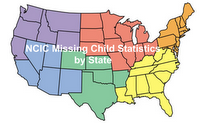
What started out as looking into the Wisconsin Amber Alert criteria based on this story of a young girl reported missing and found. I instead uncovered this interesting tidbit.
“….The National Crime Information Center (NCIC), which is part of the Criminal Justice Information Services Division within the Federal Bureau of Investigation, provides every state with a monthly report detailing statistics regarding the number of missing children in the state that month. The numbers reflect the total active missing children cases reported to NCIC for that month….”
If this is in fact true, Why doesn’t each state make these statistics available monthly? Why doesn’t the NCMEC make them available to support their efforts? Why is most of the data available via the internet, from law enforcement agencies, several years old?
Thursday, July 06, 2006
Operator, 911 or Amber Alert?
Apparently, the father dropped off the child’s mother at the mall and was not heard from again. The family was concerned because the father was diabetic man who missed insulin shots and the missing child was a 3-year-old.
Evidently the father and son had been driving to Greensburg when a faulty fuel pump, running out of gas and being unable to remember any phone numbers caused their 24-hour delay.
Why didn’t the father dial an O for the operator and ask for assistance or even dial 911?
Alert not used in missing child case
By: Jeremy Bridges
2theadvocate.com staff writer
Published: Jul 5, 2006
Tuesday, July 04, 2006
Deep in the heart of Texas
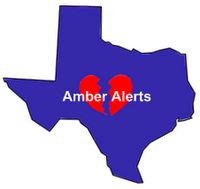
It is fascinating when the debate ensues regarding whether an Amber Alert should have been issued or not. There is merit in not abusing the system. The Texas Department of Public Safety, DPS, has only issued Amber Alerts for 27 children since August 2002. That is 27 alerts over 47 months or 1 every 1.75 months. Texas unlike some states, such as Colorado, does not post the total number of total missing children each year.
Since January of 2002, California has issued 90 Amber Alerts or 1 every .75 months and recovered 117 children.
Toddler didn't meet Amber Alert criteria
Irving: Case lacked proof of kidnap, but chief says he 'couldn't rule it out'
“….The Irving Police Department could face an informal reprimand for issuing an Amber Alert for 2-year-old Elian Majano, who disappeared from a park more than a week ago and is still missing….”
The Texas Department of Public Safety operates its own statewide Amber Alert system with even stricter rules. Elian's case would not have been eligible for that alert because a description of the suspect is required.
Lisa Block, a DPS spokeswoman, said that such stringent standards ensure that the system isn't overused and remains effective. Since the system was created in August 2002, DPS has issued Amber Alerts for 27 children. Twenty-five were returned safely, one child was killed and one is still missing. ..”
Apparently not everything is bigger in Texas.
Sunday, July 02, 2006
Lip Service?
 MySpace advertising policy is allegedly going to be altered to target appropriate age groups. Does that mean they haven’t been properly targeted?
MySpace advertising policy is allegedly going to be altered to target appropriate age groups. Does that mean they haven’t been properly targeted?For instance, ads for mature online dating sites will not be presented to minors. This would be exemplary except their newly appointed security czar suggests there are no current age verification systems available.
How can you target age appropriate ads if you can't verify the age you are targeting? Is it just lip service or is it talking out of both sides of your mouth or the best they can do? Decide for yourself, read about MySpace’s new enhanced safety features.
Saturday, July 01, 2006
Summer School?
Internet providers divided on anti-porn plan
By Kurt Eichenwald The New York Times
Published: June 28, 2006
In hearings before a subcommittee of the House Energy and Commerce Committee this was part of the testimony given by AOL.
"Warehousing of data requires the allocation of enormous resources," John Ryan, the chief counsel of compliance and investigations at the AOL unit of Time Warner, said.
"Creating such a voluminous database will actually frustrate law enforcement's goal of locating and identifying the suspects they are pursuing," Ryan said.
Ryan said an analysis by his company showed that storing and maintaining such data for a year would cost AOL about $44 million
Glance at this PDF and you will see 2005 was not to bad of a year for AOL.

Is cost really an issue? Maybe a redirection of some of the current taxes, surcharges and fee's could provide the funding?

Friday, June 30, 2006
David and Goliath
Child Sex as Internet Fare, Through Eyes of a Victim
The Courier-Journal,By James R. Carroll, Published: April 5, 2006
Congress hears Web sex victim
Whitfield leads inquiry into sexual exploitation
These articles suggest the sexual exploitation of children on the Internet, according to witnesses testifying before congress, is a $20 billion industry. Five of the US’s biggest Internet companies have pledged a total of $1,000,000 to fight child porn.
It reminds me of David and Goliath but not sure the outcome will be the same.

Thursday, June 29, 2006
Animal Farm

Did the same ISP’s committed to stopping the abuse, financially profit indirectly from the trafficking of these images?
It seems to be analogous to closing the barn door after the animals got out. Better late then never.
Read more
Wednesday, June 28, 2006
Between the lines
NCMEC’s Online Victimization Report (bolded items). The italicized items are the between the line observations.
- One in five children online is sexually solicited.
(80% of children online have not been sexually solicited) - One in thirty-three received an aggressive sexual solicitation—a solicitor who asked to meet them somewhere; called them on the telephone; sent them regular mail, money, or gifts.
(3% of those on-line have received an aggressive sexual solicitation) - One in four had an unwanted exposure to pictures of naked people or people having sex in the last year.
(75% have not had an unwanted exposure) - About one quarter of the youth who encountered a sexual solicitation or approach told a parent.
(75% of youth who encountered a sexual solicitation or approach did not tell a parent) - Almost 40 percent of those reporting an unwanted exposure to sexual material told a parent or guardian.
(60% of those reporting an unwanted exposure to sexual material never told a parent or guardian)

Tuesday, June 27, 2006
Crime & Punishment
The Uniform Crime Reporting (UCR) Program is a nationwide, cooperative statistical effort of more than 17,000 city, university and college, county, state, tribal, and federal law enforcement agencies voluntarily reporting data on crimes brought to their attention. During 2004, law enforcement agencies active in the UCR Program represented 94.2 percent of the total population.
Crime in the United States
by Volume and Rate per 100,000 Inhabitants, 1985 - 2004
Violent crime-
Murder and non-negligent manslaughter
Forcible rape
Robbery Robbery rate
Aggravated assault
Property crime
Burglary
Larceny-theft
Motor vehicle theft

View table
Monday, June 26, 2006
The picture of Dorian Gray
However if you visit the the Oregon Museum for Science and Industry there is an Age Machine. It may strictly be for amusement or not accurate, but it suggests the technology might exist.
“…Come face to face with the reality that time changes your appearance. Sit at this computer station and record a black and white picture of your face. Then, using customized software, enter your current age and gender and watch your face “age” up to 25 years! (8-adult)…”

Sunday, June 25, 2006
Not so prime numbers....
 I was reading this article dated June 23, 2006 about a Springfield, MO based company Prime Inc., one of the nation's largest truckload carriers, and their announcement that it has joined the AMBER Alert Highway Network, an initiative to help recover abducted children.
I was reading this article dated June 23, 2006 about a Springfield, MO based company Prime Inc., one of the nation's largest truckload carriers, and their announcement that it has joined the AMBER Alert Highway Network, an initiative to help recover abducted children.In the bottom of the article, there is a blurb about the NCMEC….
“…Since its establishment in 1984, NCMEC has assisted law enforcement with more than 119,800 missing child cases, resulting in the recovery of more than 102,200 children….”
If they have assisted in 119,800 cases with 102,220 recoveries, wouldn’t the recovery rate percentage be 85% and not the 96% they claim?
Saturday, June 24, 2006
How ready is your Police Department?

While I would applaud the efforts of the Searcy AR Police department to implement Policies and procedures, why did it take ten years?
Searcy police are ready for child abductions
“…During the program, Bright and Dillon learned through interactive exercises designed to illustrate steps involved in an AMBER Alert. Case studies of previous AMBER Alerts were examined and exercises designed to improve coordination between media and law enforcement were conducted.Amber Hagerman, 9, was kidnapped while riding her bicycle in Arlington, Texas, and later brutally murdered. An early warning system was conceived in 1996 as a memorial to her, and Dallas area broadcasters came up with the idea of using Emergency Alert System (EAS) equipment to rapidly relay child abduction information….”
Thursday, June 22, 2006
Policies and procedures
In an article originally published Aug. 3, 2005 by JASON NARK, Courier-Post Staff CAMDEN he writes about three boys who died tragically in the trunk of an abandoned car.
Among the questions that arose after they were found were did the families of three Cramer Hill boys put police at a disadvantage by waiting more than three hours to report their disappearance? Was it solely the responsibility of law enforcement to look in the trunk of the vehicle?
In an article today, Thursday, June 22, 2006 by RENEE WINKLER, Courier-Post Staff CAMDEN
“.. Elba N. Cruz, the mother of Anibal Cruz, has filed suit against Camden City and County, the Camden County Prosecutor's Office and even Cherry Hill Township, which provided a K-9 unit to help in the search for the boys.
It was in Cruz's Bergen Avenue yard the car was parked. She reportedly told police her son had a habit of pulling down the back seat of the Toyota Camry and crawling into the trunk while it was being driven. No one checked the trunk of the car until it was too late…”

To view pdf
Wednesday, June 21, 2006
Summer Solstice
 Long day or bad day....
Long day or bad day....MySpace Tightens Age Restrictions
Effort To Curb Adult Predators Who Seek To Contact Teens
Bloggers Eye Topless Teacher
Tamara Hoover Is Fired When Topless Photos Of Her Show Up Online
Local Sheriff's Deputy Fired Over MySpace Profile
Tuesday, June 20, 2006
NCAA...stats..
Few dispute the overall value of Amber Alerts. This article discusses the technology and a case that could have used it back in 1966. In the article there is a quote from Cathy Nahirny, who's been with the NCMEC for 16 years.
“…Between 1997 and 2005, 275 Amber Alerts were issued, Nahirny said. Of 338 children shown in those alerts, 335 were recovered; 322 of them were fine. Thirteen died…”
The question I would have is if you view juvenile statistics for North Carolina for the same period, you may wonder if enough Amber Alerts were issued as there were 64,465 missing juveniles over the same timeframe.
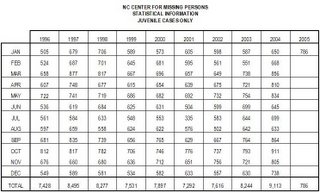
Saturday, June 17, 2006
Hide and seek
These are a couple services from Sprint and Verizon available for parents to monitor their children’s location via a wireless phone. It is important to note the phones need to be turned on, within specific coverage areas and in the child’s possession to be of value.How realistic is it to expect the child to still have the phone should they be abducted? If they were lost, and not missing, wouldn’t they just call their parents?
What is Sprint Family Locator?

Sprint Family Locator is an inexpensive way for families on the go to stay in constant touch. Mom, Dad or a trusted caregiver can locate loved ones without disturbing their activities, receive notification when a child enters or leaves a designated area, and quickly and easily send text messages to one or more family members.
What is Chaperone?
Chaperone provides a convenient and valuable service to help you determine the location of your child’s mobile phone from the Internet or from your mobile phone. When your children
 carry their Verizon Wireless phones with them while on the go, you can use the Chaperone Web Site or the Chaperone Get It Now® application to view their location information. Your child's location information will be displayed as a nearby address and on a detailed map.
carry their Verizon Wireless phones with them while on the go, you can use the Chaperone Web Site or the Chaperone Get It Now® application to view their location information. Your child's location information will be displayed as a nearby address and on a detailed map.An interesting article discusses some of the pros and cons of these offerings.
Friday, June 16, 2006
The Family that plays together....
“…..Qwest Communications and the National Center for Missing & Exploited Children (NCMEC) are working together to inform families about the dangers our youth face while using the Internet.
Recognizing the lack of parental awareness and the increasing risks to children, Qwest Communications has partnered with the National Center for Missing & Exploited Children (NCMEC) to develop a comprehensive campaign to provide parents and guardians with the necessary resources to establish safer online practices for their families…”
If you attempt to learn more about available resources such as an Internet Glossary, you are redirected to the NetLingo site. At the bottom of the screen is a list of NetLingo Partners.

Credit Card Application? Prepaid Phone? Poker? Casinos? Gambling?
Thursday, June 15, 2006
Two cents worth

This is an interesting article involving a murdered child in Indiana which discusses the issue of when to issue an Amber Alert.
Why are there 116 Amber Alert systems if there are only fifty states?
"...Each of the 116 Amber Alert systems throughout the country has its own rules for issuing notices, said Robert Hoever, director of special operations at the National Center for Missing & Exploited Children..."
Why wouldn’t you issue an Amber Alert if family abductions represent the second largest category of missing children?
The Indiana system launched in 2002, does not typically allow alerts in child custody cases.
Saturday, June 10, 2006
Weekend at Bernie’s…… (part III)

Perhaps MySpace.com should merge with one of the travel sites or luggage companies. New meaning to the term exchange student.
Tuesday, June 06, 2006
8 Simple Rules....not the tv show
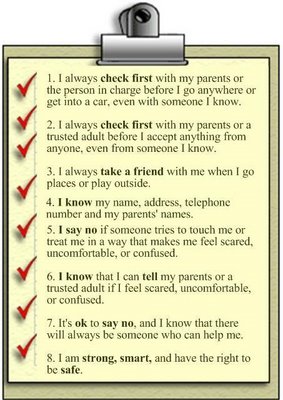
ARE THERE WAYS TO PREVENT MY CHILD FROM BEING ABDUCTED?
"...You can also talk to your child about ways to prevent an abduction from happening. The FBI, the Office of Juvenile Justice and Delinquency Prevention (OJJDP), and the National Center for Missing and Exploited Children (NCMEC) offer these eight rules for your child's safety..."
Some more helpful tips from the CBS Cares website.
Monday, June 05, 2006
CBS Cares PSA's
CBS Cares is running several public service announcements concerning child abductions. This one provides some tips for WHAT IF AN ABDUCTOR APPROACHES MY CHILD?

“If someone tries to abduct your child, your child should resist every step of the way.”-Supervisory Special Agent Mick Fennerty of the FBI's Crimes Against Children Unit
GENERAL INFORMATION
"...It could happen in the time it takes to snap your fingers: Your child could disappear. In 1999, the Office of Juvenile Justice and Delinquency (OJJDP) reported that there were 58,200 non-family abductions. Fifty percent of children kidnapped in non-family abductions were taken from the street, in a vehicle, or from a park or wooded area. Many didn't know what to do. It happens too often and you can prevent it from happening to your child if you take the time to talk to them. In an interview with CBS Cares, Agent Fennerty of the FBI who specializes in investigating crimes against children, including child abduction cases, conveyed that it is never too early to start training your child to protect themselves from being abducted. Learn what your child should do in a dangerous situation, so you can teach them what to do to avoid being snatched and what to do if snatched! Know what they can do to save themselves. .."
HOW DO I PROTECT MY CHILD?
Saturday, June 03, 2006
Missing Child Resources

The Missing Child Resources link is a list of some of the assistance available to you should your child go missing. It will periodically be updated, however please suggest any other sites.
Thursday, June 01, 2006
Amber Alerts
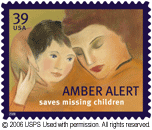
The AMBER Plan was created in 1996 as a powerful legacy to 9-year-old Amber Hagerman, a bright little girl who was kidnapped and brutally murdered while riding her bicycle in Arlington, Texas.
How do AMBER Alerts work?
Once law enforcement has been notified about an abducted child, they must first determine if the case meets the recommended criteria from the U.S. Department of Justice for activating an alert.
Guidance on Criteria for Issuing AMBER Alerts (PDF)
- There is reasonable belief by law enforcement an abduction has occurred
- The abduction is of a child age 17 years or younger
- The law-enforcement agency believes the child is in imminent danger of serious bodily injury or death
- There is enough descriptive information about the victim and abduction for law enforcement to issue an AMBER Alert to assist in the recovery of the child
- The child’s name and other critical data elements, including the Child Abduction flag, have been entered into the National Crime Information Center (NCIC) computer
It is important to note that though it is suggested “…what began as a local effort in Dallas, Texas, has grown into a seamless system of AMBER Alert programs across the country…” it is at the discretion of local law enforcement if it should be issued and to each state as to whether it is valid across state lines.
Wednesday, May 31, 2006
Training the trainer?
This would indicate on average they trained @ 20,444 individuals per year. The Fiscal year 2005 training budget, from their annual report for last year, was $4,336,861 so at least for FY 2005 it would average @$212 per individual. If you look at their course offerings which are fairly extensive, and the fact they pay expenses to attend the courses, possibly allocation of training expense is an issue as it represents only 11% of the total program expenses.
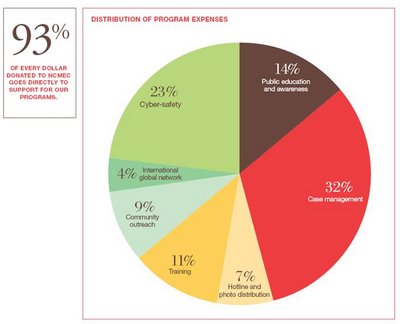
These are the costs incurred to attend training, and what is provided?

*Continental breakfast and buffet lunches will be provided at all training sessions in NCMEC facilities in Alexandria, VA, and Rochester, NY.
This would appear based on the available training schedules to be only a fraction of the educational services they provide as the courses don't include LOCATER training etc.
NCMEC Training
Tuesday, May 30, 2006
Nip it..Nip it..Nip it...

While searching the various Missing Children blogs,there is an interesting post concerning a La Salle Il. police chief at the Kids Search Network blog .
Missing and Abducted Children: A Law-Enforcement Guide to Case Investigation and Program Management
Authored by a team of 38 professionals from local, state, and federal agencies, this guide outlines a standard of practice for law-enforcement officers handling missing-child cases whether runaways, thrownaways, family/nonfamily abductions, or when the circumstances of the disappearance are unknown. It describes — step-by-step with definitive checklists — the investigative process required for each of these types of cases and offers a wealth of resources to assist an investigator. 224 pp.
Download this publication (PDF)English
Monday, May 29, 2006
$64k question not a $32,565,881 one
According to their site information, since its establishment in 1984, NCMEC has assisted law enforcement with more than 117,100 missing child cases, resulting in the recovery of more than 99,500 children.
Their 2005 Annual Report indicates, "...NCMEC has played a key role in raising our nation’s recovery rate of missing children from 62 percent in 1990 to more than 96 percent today..."
Here is what I don't understand

However, the questions that I have are:
1) What happened to all the other children? They were established in 1984. If @880k children go missing that are reported each year (an estimated 500,000 more are not reported) wouldn’t that mean 17,600,000 give or take a few million have gone missing since 1984. They have recovered 99,500 children which is certainly admirable.
2) What is the recovery success ratio of 96% based on? Is it only based on non family abductions or do they include those classified as throwaways, runaways, family abductions, voluntarily missing, lost or injured?
3) What is the actual number of children recovered and what was the criteria used to classify them?
Thursday, May 25, 2006
May 25th - National Missing Children's Day
 Proclaimed National Missing Children’s Day by President Ronald Reagan in 1983, May 25th serves as an annual reminder to make child protection a national priority.
Proclaimed National Missing Children’s Day by President Ronald Reagan in 1983, May 25th serves as an annual reminder to make child protection a national priority.Please take a few minutes to view the currently missing children at the National Center for Missing & Exploited Children site
http://www.missingkids.com/
Wednesday, May 24, 2006
Criminal minds

Some parents and guardians are concerned with their children's safety and fear the potential risk of the internet. It is important to distinguish between types of internet crimes.
- Crimes commited by on-line predators who search for children in chat rooms or for those children who place their personal information on a weblog (Blog)
- White collar crimes
The Internet Crime Complaint Center (IC3) was established as a partnership between the Federal Bureau of Investigation (FBI) and the National White Collar Crime Center (NW3C) to serve as a means to receive Internet related criminal complaints.
Most common and ongoing Internet trends and schemes identified by the Internet Crime Complaint Center (IC3):
· Auction Fraud
· Auction Fraud - Romania
· Counterfeit Cashier's Check
· Credit Card Fraud
· Debt Elimination
· Parcel Courier Email Scheme
· Employment/Business Opportunities
· Escrow Services Fraud
· Identity Theft
· Internet Extortion
· Investment Fraud
· Lotteries
· Nigerian Letter or "419"
· Phishing/Spoofing
· Ponzi/Pyramid
· Reshipping
· Spam
· Third Party Receiver of Funds
http://www.ic3.gov/media/IC3-flyer.pdf
Tuesday, May 23, 2006
On-line risks
Often time parents or guardians hesitate to register their children with an online service due to their own fear of the internet. Little do they realize their children are often very active users either at home, school, in a library or at a friend’s home.
Interesting excerpt from the netzsmart.org website http://www.netsmartz.org/safety/risks.htm
“...Before spending valuable learning time on activities to reduce child victimization online, it is important to understand the need for this information. Children of all ages are flocking to the Internet. Forty-five percent of children in the United States — more than 30 million of those younger than 18 — use the Internet.1
It is important to note the types of dangers that children may be susceptible to on the Internet. In addition to the useful and educational information available on the Internet, a great deal of content exists that is not appropriate for children. This content can include nudity or other sexually explicit material; hate group or racist web sites; promotional material about tobacco, alcohol, or drugs; graphic violence; information on satanic or cult groups; or even recipes for making bombs or other explosives. 2…”
1More Online, Doing More. Washington, DC: The Pew Internet & American Life Project, 2001, page 2.
2Internet Safety. Atlanta, Georgia: Boys & Girls Clubs of America, 2001, page 13.
Monday, May 22, 2006
How many missing children are there?
 Answer:
Answer:The problem of missing children is complex and multifaceted. There are different types of missing children including family abductions; endangered runaways; nonfamily abductions; and lost, injured, or otherwise missing children.
The best national estimates for the number of missing children are from incidence studies conducted by the U.S. Department of Justice's Office of Juvenile Justice and Delinquency Prevention. To date two such studies have been completed.
The first National Incidence Studies of Missing, Abducted, Runaway, and Thrownaway Children (NISMART-1) was released in 1990, and the second, known as NISMART-2, was released in October 2002. According to NISMART-2 research, which studied the year 1999, an estimated 797,500 children were reported missing; 58,200 children were abducted by nonfamily members; 115 children were the victims of the most serious, long-term nonfamily abductions called "stereotypical kidnappings"; and 203,900 children were the victims of family abductions.
REFERENCE: For more information on missing children abduction estimates and the NISMART studies, please read
NISMART-2, October 2002. National Estimates of Missing Children: An Overview Adobe PDF
NISMART-2, October 2002. Nonfamily Abducted Children: National Estimates and Characteristics Adobe PDF
NISMART-2, October 2002. Children Abducted by Family Members: National Estimates and Characteristics Adobe PDF
NISMART-2, October 2002. Runaway/Thrownaway Children: National Estimates and Characteristics Adobe PDF
NISMART-2, October 2002. NISMART Questions and Answers Adobe PDF
Sunday, May 21, 2006
There are several ways to categorize missing children...

• Your child can be missing briefly because of a minor misunderstanding or childhood forgetfulness, during which he may not even know that his parents consider him missing
• A child may also get lost, or may be injured in a place where he can’t call for help
•A child may be a runaway: the majority of missing adolescents are runaways
• A child may be a “throw-away”, a child actually told by a caretaker to leave home
• A child may be abducted by a relative, most often as the result of a custody or visitation dispute
• A child may be the victim of a non-family abduction. This category includes the Stereotypical Kidnapping, which is the most frightening of circumstances and, as a federal crime, requires the involvement of the FBI.
* Statistics based on Office of Juvenile Justice and Deliquency Prevention


